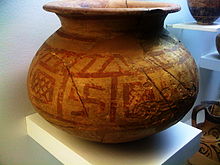Histri


The Histri or Istri[1] (Ancient Greek: Ἴστροι)[2] were an ancient people inhabiting the Istrian Peninsula, to which they gave the name Histria. Their territory stretched to the neighbouring Gulf of Trieste and bordered the Iapodes in the hinterland of Tarsatica.[3] The Histri formed a kingdom.[3][4]
Description
[edit]
They are classified in some sources as a Venetic tribe, with some ties with the Illyrians,[5] or a purely Illyrian tribe.[1][6][7][2] The Histri are also described as Thracians;[8][2] an orientation includes them in the Liburnian linguistic area.[9]
Since they inhabited the Istrian peninsula, they had more intensive trade and cultural contacts with the Mediterranean world, particularly central and southern Italy.[3]
The Romans described the Histri as a fierce tribe of pirates, protected by the difficult navigation of their rocky coasts. An account stated that this tribe was first in the northern Adriatic area to be threatened by the Roman imperialism and to start a war.[10] It took two military campaigns for the Romans to finally subdue them in 177 BCE.[10]
In the Augustan age the most of Istria was then called, together with the Venetian part, the X Roman region of Venetia et Histria: the ancient definition of the northeastern border of Italy. Dante Alighieri refers to it as well; the eastern border of Italy per ancient definition is the river Arsia.
See also
[edit]References
[edit]Citations
[edit]- ^ a b "Harry Thurston Peck, Harpers Dictionary of Classical Antiquities (1898), Istria". www.perseus.tufts.edu. Retrieved 2024-10-27.
- ^ a b c "Dictionary of Greek and Roman Geography (1854), I´STRIA". www.perseus.tufts.edu. Retrieved 2024-10-27.
- ^ a b c Dzino 2010, p. 42
- ^ Mesihović 2014, p. 219.
- ^ Wilkes 1992, p. 183: "... We may begin with the Venetic peoples, Veneti, Carni, Histri and Liburni, whose language set them apart from the rest of the Illyrians...."
- ^ "The Princeton Encyclopedia of Classical Sites, NESACTIUM (Vizače) Croatia, Yugoslavia". www.perseus.tufts.edu. Retrieved 2024-10-27.
- ^ "Charlton T. Lewis, Charles Short, A Latin Dictionary, Histri". www.perseus.tufts.edu. Retrieved 2024-10-27.
- ^ Katičić 1976, p. 130
- ^ "Early Iron Age (map)". Indo-european.eu: Languages, Cultures & Peoples. May 2021.
- ^ a b Luthar 2008, p. 40
Bibliography
[edit]- Dzino, Danijel (2010). Illyricum in Roman Politics, 229 BC–AD 68. Cambridge University Press. ISBN 978-0-521-19419-8.
- Ferguson, Ronnie (2007). A Linguistic History of Venice. Firenze: Leo S. Olschki. ISBN 978-88-222-5645-4.
- Katičić, Radoslav (1976). Ancient Languages of the Balkans. The Hague: Mouton & Co. N.V., Publishers. ISBN 9783111568874.
- Luthar, Oto (2008). The Land Between: A History of Slovenia. Frankfurt am Main: Peter Lang. ISBN 9783631570111.
- Matijašić, Ivan (2011). ""Shrieking like Illyrians": Historical geography and the Greek perspective of the Illyrian world in the 5th century BC". Arheološki Vestnik. 62. Research Centre of the Slovenian Academy of Sciences and Arts: 289–316.
- Mesihović, Salmedin (2014). ΙΛΛΥΡΙΚΗ (Ilirike) (in Bosnian). Sarajevo: Filozofski fakultet u Sarajevu. ISBN 978-9958-0311-0-6.
- Mesihović, Salmedin; Šačić, Amra (2015). Historija Ilira [History of Illyrians] (in Bosnian). Sarajevo: Univerzitet u Sarajevu [University of Sarajevo]. ISBN 978-9958-600-65-4.
- Wilkes, John J. (1992). The Illyrians. Oxford, United Kingdom: Blackwell Publishing. ISBN 0-631-19807-5.